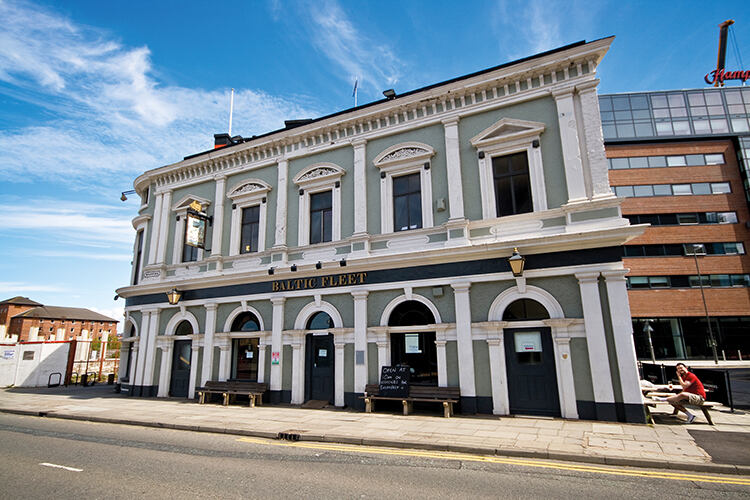
Rory Walsh drops in on famous pubs in Edinburgh, Glasgow, Liverpool and Nottingham
Discovering Britain
Barely a weekend passes without a newspaper supplement somewhere featuring ‘Great Pub Walks’. Most routes focus on the scenery, with the pub offering a convenient starting point or incentive to reach the end. Yet many pubs have their own stories to tell. Besides liquid refreshment, they serve measures of geography. Discovering Britain’s 200-plus walks and trails include various stops at or about pubs. As Dick Bateman, retired geography teacher and Discovering Britain walk creator, suggests, ‘You can’t walk past a pub – you have to walk through it.’
This potted pub crawl visits just a few featured in Discovering Britain walks, beginning with an end. The World’s End is one of the most popular pubs in Edinburgh. Located roughly halfway along the Royal Mile, the apocalyptic-sounding name is undoubtedly part of its appeal. Visitors pop in from worldwide, leading to countless anecdotes (and these days social media posts) about ‘last orders’. A set of brass plaques that span the road outside, marking the site of the Netherbow Port, a fortified gate, offers a clue to the pub’s name and geographical origins.
For centuries, Scotland and England were military enemies. In 1513, around 10,000 Scottish troops, including King James IV, were killed in the Battle of Flodden in Northumberland. Afterwards, the Scots built walls around Edinburgh to protect the city. The exterior of the World’s End was originally part of the defences. The Netherbow Port was the main gate. Access through it was granted by tolls, which applied to residents as well as visitors. When the walls were built, many locals lived in poverty and couldn’t afford to pay the toll. Confined by the cost, as well as fears that leaving the city was unsafe, their world ended at the walls.
From impoverished 16th-century Edinburgh, the next pub represents thriving Glasgow. In the Victorian era, Glasgow was wealthy and confident, mainly due to shipping on the Clyde. The city’s fortunes are reflected in the buildings in its centre. On the corner of Jamaica Street stands the Crystal Palace. Now a branch of Wetherspoons, it opened in 1856 as Gardner’s Warehouse and was used for storing and selling furniture. The facades feature more than 100 windows, which extend from floor to ceiling on two levels.
The name Crystal Palace refers to the vast venue in London’s Hyde Park, which hosted the Great Exhibition of 1851. Why does a Glasgow pub invoke a lost London landmark? The answer is radical design. The original Crystal Palace was a temporary structure made from plate glass in a cast-iron frame. Gardner’s Warehouse was the UK’s first permanent building to use the same method and materials. Innovation extended to the interior. The pub has what’s thought to be Britain’s oldest lift. Remarkably, it still works.

Also confident was Victorian Liverpool. At its commercial peak, an incredible 40 per cent of the world’s shipping passed through Liverpool port. A pub facing the Royal Albert Dock provides a reminder of this seafaring heritage. The Baltic Fleet’s wedge-shaped profile recalls the prow of a ship. Inside, the décor has a maritime theme. The road outside, Wapping, is a former rope walk. The name derives from ‘warping’, the traditional way of making rope by twisting fibres together. Meanwhile, the Baltic Fleet’s name came from its historical clientele.
Patrons today are said to include several ghosts. In times past, the regulars were Scandinavian sailors, among them crews from Siberian whaling ships. The oldest parts of the Baltic Fleet date from the 1780s. By the mid-19th century, Liverpool’s Scandinavian community, comprising visiting seamen and migrants who had settled in the city, was large enough to require a church. Gustaf Adolf Kyrka is a two-minute walk from the pub. Meanwhile, tunnels in the Baltic Fleet’s cellar, now blocked up, once led directly to the docks.
Another pub with subterranean spaces is Ye Olde Trip To Jerusalem. ‘The Trip’, as locals affectionately call it, sprouts from Castle Rock, the steep sandstone outcrop that supports Nottingham Castle. The pub claims to be ‘the oldest inn in England’; the date 1189 appears on the whitewashed walls. According to local legend, King Richard I’s knights drank there before heading to the Crusades. Two other Nottingham inns, Ye Olde Salutation and the Bell, also claim to be England’s earliest. There are several other very old pubs in the city. Their beer sprang from stone.
Nottingham developed on a sandstone ridge formed around 245 million years ago. Sandstone can be cut with basic tools. As a result, the city is laced with more than 540 caves, all made by human hands. Among them are the Trip’s cellars and upstairs rooms, hewn into Castle Rock. Caves provide perfect conditions for brewing and storing beer – low light and a cool constant temperature of 14°C. Sandstone is also a good material for aquifers, holding water underground. Brewers therefore had a steady supply. When diseases such as typhoid and cholera were widespread, beer was safer to drink than water as brewing removed dangerous impurities.
Discover more about Britain…
Despite tantalising suggestions of a medieval pub on the site, the Trip’s origins can only be confirmed to 1751. Beyond doubt, however, is that visitors can see and touch millions of years of history in the pub’s walls. Sadly, the same no longer applies to the last pub on this route. Located in Himley in Staffordshire, the Crooked House was originally a farm building. Subsidence made it lean by about 1.3 metres. The cause was the Black Country’s diverse geology, which saw the area extensively mined for coal, limestone, iron ore, clay and sand. Condemned as unsafe in the 1940s, the pub was stabilised by a Midlands brewery and became a quirky attraction.
In August 2023, the Crooked House caught fire overnight before being demolished. The circumstances made international headlines and a police investigation is still underway. Although listing, the Crooked House wasn’t listed and its destruction has publicised debates about protecting historic pubs. The town’s MP is campaigning for a ‘Crooked House Law’, while CAMRA (the Campaign for Real Ale) has received a surge in enquiries about nominating pubs as Assets of Community Value. Recent data indicate that due to financial pressure – on customers and the industry alike – Britain’s pubs are closing at the rate
of two per day.
This article was partly inspired by the loss of the Crooked House. It also provides a mere sip of the many pubs that appear on the Discovering Britain website. Others include a London pub by a hidden river; an Essex pub by a lost racecourse; a Sussex smugglers’ hideout; the pub that founded a Welsh resort… From small village watering holes to large urban boozers, each one is part of Britain’s geographical cocktail.

Go to the Discovering Britain website to find more hikes, short walks, or viewing points. Every landscape has a story to tell!



